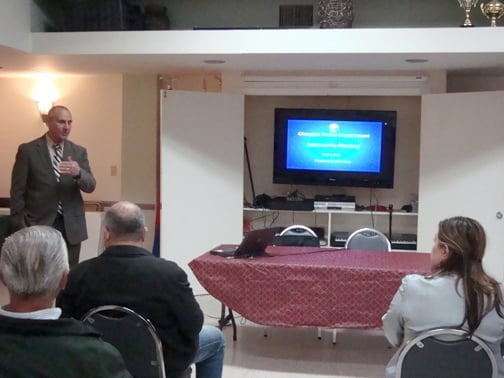
Detective Matt Zakarian outlined tips to avoid being a victim of identity theft at a seminar hosted by the CV Armenian Community & Youth Center.
By Jason KUROSU
The Crescenta Valley Armenian Community & Youth Center hosted an event Tuesday night detailing the most common forms of identity theft and strategies for protecting against becoming a victim to this ever-increasing crime.
Matt Zakarian, detective with the Glendale Police Dept. Financial Crimes Unit, spoke to a small audience about his experiences dealing with different types of fraud, including identity theft.
Zakarian outlined the growing prevalence of identity theft, noting that 15.3 million people age 16 and older were victims of identity theft in 2012, totaling 6% of the country’s population. The Federal Trade Commission ranked California third, in a 2013 list of states with the most identity theft per capita, preceded only by Florida and Georgia.
He said that identity theft comes in three major forms: unauthorized use of existing credit cards, checking accounts or from the creation of new accounts using stolen personal information. Eliciting that personal information is central to identity theft.
Zakarian noted that elder abuse has risen as thieves are preying more and more on seniors who are unfamiliar with such scams.
“Grandma or Grandpa will get a call saying, ‘Your grandson, Eddie, is in jail. He needs $500 down to get out.’ Once that money gets wired, the thief knows he’s got a good one. So they’ll call back and say ‘You know what? The $500 wasn’t enough. We realize now it was actually $1,000.’ And they do that two, three times until they stop getting any more.
“And how did they find out your grandson’s name is Eddie? That info’s on the internet, probably on Facebook under a picture titled ‘Grandma and Eddie.’”
Techniques for stealing personal information range from as sophisticated as fake websites that replicate trusted sites such as bank homepages where customers regularly input personal information to as crude as stealing information straight out of mailboxes or dumpsters.
Predicting when one might be susceptible to identity theft is difficult for this reason, but Zakarian urged caution as an overall effective strategy.
“Be careful with your personal information,” said Zakarian, who said that he burns or shreds any piece of mail to be discarded.
But simple awareness of one’s banking was a key point, as identity theft may go undetected otherwise. Automated fraud alerts for large expenditures from one’s bank account can help customers be aware of suspicious transactions under their name.
“You can be paranoid and vigilant, but the most important thing to do is to keep track of your bank accounts,” Zakarian advised.
He also recommended photocopying important documents and not responding to unsolicited phone calls or emails.
Some members of the audience said they had been victims of various forms of financial crime – and Zakarian was among them. His credit card information was used to buy prescription medication at a North Carolina Walgreens.
Luckily, Zakarian said, banks are becoming more knowledgeable about their customers’ habits, allowing them to accurately identify instances of identity theft.
“The bank knows I don’t go to North Carolina very often to fill my prescriptions,” he said.
Zakarian recommended that victims of identity theft visit www.idtheftcenter.org for assistance, in addition to speaking with their banks and filing a police report.
